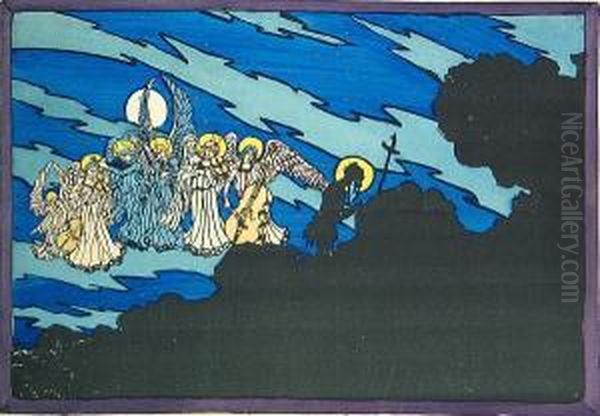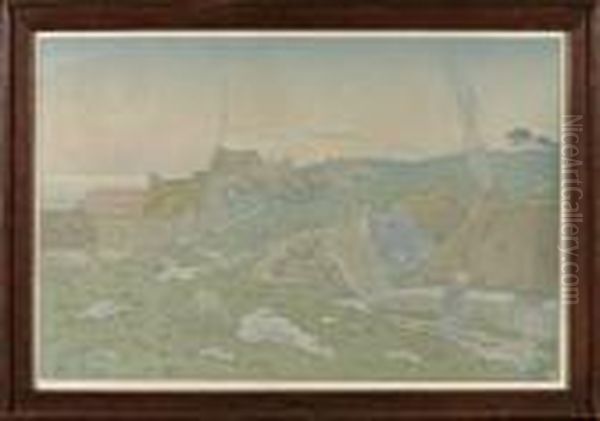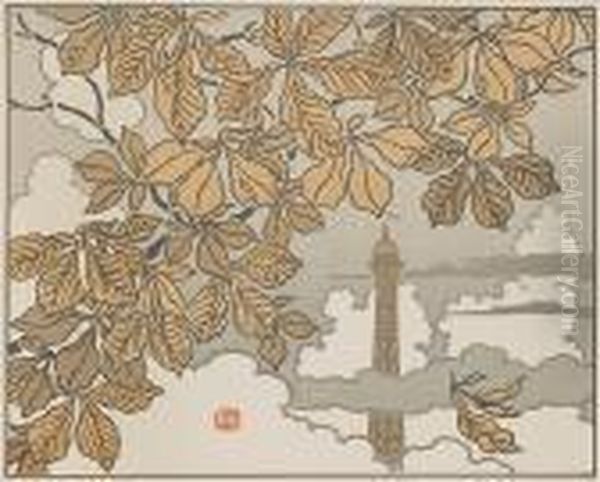The history of art occasionally presents figures whose similar names can lead to confusion. Such is the case with Henry Parsons Riviere and Henri Rivière. One, an English watercolourist active in the mid-19th century, and the other, a French master of printmaking and theatre arts flourishing at the turn of the 20th century. While sharing a surname, their artistic paths, styles, and legacies diverged significantly. This exploration delves into the lives and works of both artists, clarifying their distinct contributions and placing them within their respective historical and artistic contexts. Understanding each man's journey reveals unique facets of 19th and early 20th-century European art.
Henry Parsons Riviere (1811-1888): The British Watercolourist
Henry Parsons Riviere represents a strand of traditional British artistry, particularly skilled in the medium of watercolour. Born in London in 1811, he hailed from an artistic family. His father, Daniel Valentine Riviere, was a drawing master, and his brother, William Rivière (1806–1876), served as the drawing master at Cheltenham College and later taught art at the University of Oxford. This familial environment undoubtedly nurtured Henry Parsons Riviere's early artistic inclinations.
His career unfolded primarily within the established institutions of the British art world. He became known for his proficient watercolour paintings, a medium highly esteemed in Britain during the 19th century. Riviere exhibited his works regularly, gaining recognition through showings at prestigious venues. These included the Royal Watercolour Society, a key institution for artists specializing in the medium, and the Royal Birmingham Society of Artists, indicating his reach beyond the London art scene.
While specific details about his individual works are less documented than those of his more famous French namesake or his own nephew, his output likely consisted of landscapes and genre scenes typical of the period's watercolour tradition. His technique would have emphasized transparency, delicate washes, and careful draughtsmanship, hallmarks of the British watercolour school. He was part of a generation upholding the standards and aesthetics favoured by the Royal Watercolour Society.

Henry Parsons Riviere's most prominent connection in art history, however, often comes through his nephew, Briton Rivière (1840-1920). Briton became a highly celebrated painter, particularly known for his animal subjects and historical scenes, achieving significant fame and academic recognition, including becoming a Royal Academician. Sources note that Briton Rivière's early artistic training was largely overseen by his father, William, and influenced by his uncle, Henry Parsons Riviere, embedding him within this family tradition of art education and practice before he forged his own distinct path. Henry Parsons Riviere passed away in London in 1888, leaving behind a legacy as a competent and respected watercolourist within the British tradition.
Henri Rivière (1864-1951): The French Master of Printmaking and Japonisme
In contrast to his British near-namesake, Henri Rivière emerged as a pivotal figure in the vibrant Parisian art scene of the late 19th and early 20th centuries. Born in Paris in 1864, his life and work are inextricably linked to the innovations and artistic ferment of Montmartre and the broader Belle Époque era. His contributions spanned printmaking, illustration, photography, and the unique shadow theatre of the Chat Noir cabaret.
Early Life and Artistic Formation
Henri Rivière's initial foray into the art world involved formal training, albeit briefly. Around 1880, he studied under the painter Émile Bin. However, much of his development, particularly in the demanding techniques of printmaking, appears to have been self-driven, fueled by personal study and experimentation. His early career involved creating illustrations for various journals and magazines, honing his skills in draughtsmanship and composition while immersing himself in the graphic arts. This period laid the groundwork for his later, more ambitious projects in printmaking and theatre.
The Chat Noir and the Théâtre d'Ombres
A defining chapter in Henri Rivière's early career was his deep involvement with Le Chat Noir, the legendary Montmartre cabaret founded by Rodolphe Salis. Initially contributing illustrations and editorial work to the cabaret's journal, Rivière soon became the creative force behind its famous shadow theatre, the Théâtre d'Ombres. Starting around 1886, he developed elaborate productions using back-lit zinc cut-outs, creating intricate silhouettes projected onto a screen.
These were not simple puppet shows but sophisticated visual narratives, often featuring complex landscapes, dramatic lighting effects achieved through coloured filters, and multiple moving parts. Rivière served as director, designer, and technician for these popular spectacles, collaborating with artists like Caran d'Ache. Shows like L'Épopée and La Tentation de Saint Antoine captivated Parisian audiences with their ingenuity and artistry. This work demonstrated Rivière's innovative spirit and his ability to blend traditional techniques with modern entertainment, prefiguring elements of cinematic animation. The Chat Noir environment also placed him at the heart of Montmartre's avant-garde circle, associating him with figures like Aristide Bruant and Henri de Toulouse-Lautrec.
Japonisme and Mastery of Printmaking

Henri Rivière's most enduring legacy lies in his printmaking, particularly his colour woodcuts and lithographs, which were profoundly influenced by Japanese Ukiyo-e prints. Like many artists of his generation, including Edgar Degas, Mary Cassatt, and the Nabis painters Pierre Bonnard and Édouard Vuillard, Rivière was captivated by the aesthetics of Japanese art, which became widely available in Paris following the opening of Japan to the West. He frequented Siegfried Bing's influential gallery 'L'Art Nouveau', a major hub for Japanese art and artifacts.
Rivière didn't merely imitate; he absorbed the principles of Japanese composition, the use of flat areas of colour, decorative patterning, and unconventional perspectives, integrating them into his depictions of French landscapes and cityscapes. He mastered the complex techniques of multi-block colour woodcut printing, achieving subtle gradations and atmospheric effects reminiscent of masters like Katsushika Hokusai and Utagawa Hiroshige. His technical skill allowed him to control the nuances of colour and tone, creating prints of remarkable delicacy and depth.
Iconic Works and Series: Brittany and Paris
Two major series dominate Henri Rivière's printmaking oeuvre: Paysages bretons (Landscapes of Brittany) and Les Trente-six vues de la Tour Eiffel (Thirty-Six Views of the Eiffel Tower). Created primarily during the 1890s, the Paysages bretons series comprises over forty colour woodcuts and lithographs depicting the rugged coastline, villages, and daily life of Brittany. These works showcase his mature style, blending Japonisme with a sensitive observation of light and atmosphere, akin to Impressionist concerns but rendered through the graphic medium. The compositions often feature high horizons, flattened perspectives, and harmonious colour palettes, capturing the unique character of the region.
His Thirty-Six Views of the Eiffel Tower, produced between 1888 and 1902, is a direct homage to Hokusai's famous series Thirty-Six Views of Mount Fuji. Rivière depicted the iconic Parisian landmark from various viewpoints, at different times of day, and under diverse weather conditions, using it as a constant element against the changing backdrop of the city. This series, primarily executed in colour lithography, demonstrated his ability to apply the principles of Ukiyo-e to a quintessentially modern and European subject, capturing the dynamism and structure of the tower within carefully balanced compositions.
Other significant works include the series La Mer: Études (The Sea: Studies) and La Féerie des Heures (The Magic of the Hours), further exploring his fascination with nature, light, and time through the print medium. His prints were highly sought after by collectors and admired by fellow artists for their technical brilliance and aesthetic refinement.
Artistic Style: Synthesis and Sensitivity

Henri Rivière's style represents a unique synthesis. While deeply indebted to Japanese prints, it also resonates with aspects of Impressionism and Post-Impressionism. His sensitivity to light, weather, and atmosphere aligns him with Impressionists like Claude Monet and Camille Pissarro, though his medium was primarily graphic rather than paint on canvas. His emphasis on strong composition, decorative line, and expressive colour connects him to Post-Impressionist trends seen in the work of Paul Gauguin (who also worked in Brittany and embraced printmaking) and the Nabis group.
His friendship with the Pointillist painter Paul Signac is also noteworthy. While Rivière did not adopt the Pointillist technique, their association suggests shared interests in colour theory and modern approaches to representation. Rivière's work, however, always retained a distinct graphic clarity and a poetic, often tranquil, sensibility that set it apart. He focused on capturing the essential forms and moods of his subjects, whether the industrial geometry of the Eiffel Tower or the timeless rhythms of the Breton coast.
Photography and Later Life
Beyond printmaking and theatre, Rivière was also an early enthusiast of photography. He utilized the camera to capture scenes and studies, sometimes using photographs as aids for his prints. His photographic work, though less known, displays a similar compositional acuity and interest in light found in his prints. Some scholars suggest his photographic experiments may have influenced contemporaries like Edgar Degas, who also explored the camera's potential.
After around 1917, Rivière largely ceased making prints and turned increasingly towards watercolour. He continued to paint scenes of France, travelling and capturing landscapes with the same sensitivity that marked his earlier graphic work. He remained a respected figure in the art world, though perhaps less visible than in his Montmartre heyday. Henri Rivière passed away in Sucy-en-Brie, near Paris, in 1951, leaving a rich body of work that continues to be celebrated for its beauty, technical mastery, and its unique fusion of Eastern and Western artistic traditions.
Distinct Legacies
While Henry Parsons Riviere remains a figure primarily noted within the context of 19th-century British watercolour painting and his family's artistic lineage, Henri Rivière stands as a significant innovator in French art. His contributions to printmaking, particularly his masterful adoption and adaptation of Japanese techniques, secured his place in the history of graphic arts. His work at the Chat Noir pioneered a form of visual theatre, and his iconic images of Brittany and Paris capture the spirit of his time with enduring charm and sophistication. Recognizing the distinct identities and achievements of these two artists enriches our understanding of the diverse artistic currents flowing through Europe during their respective eras.